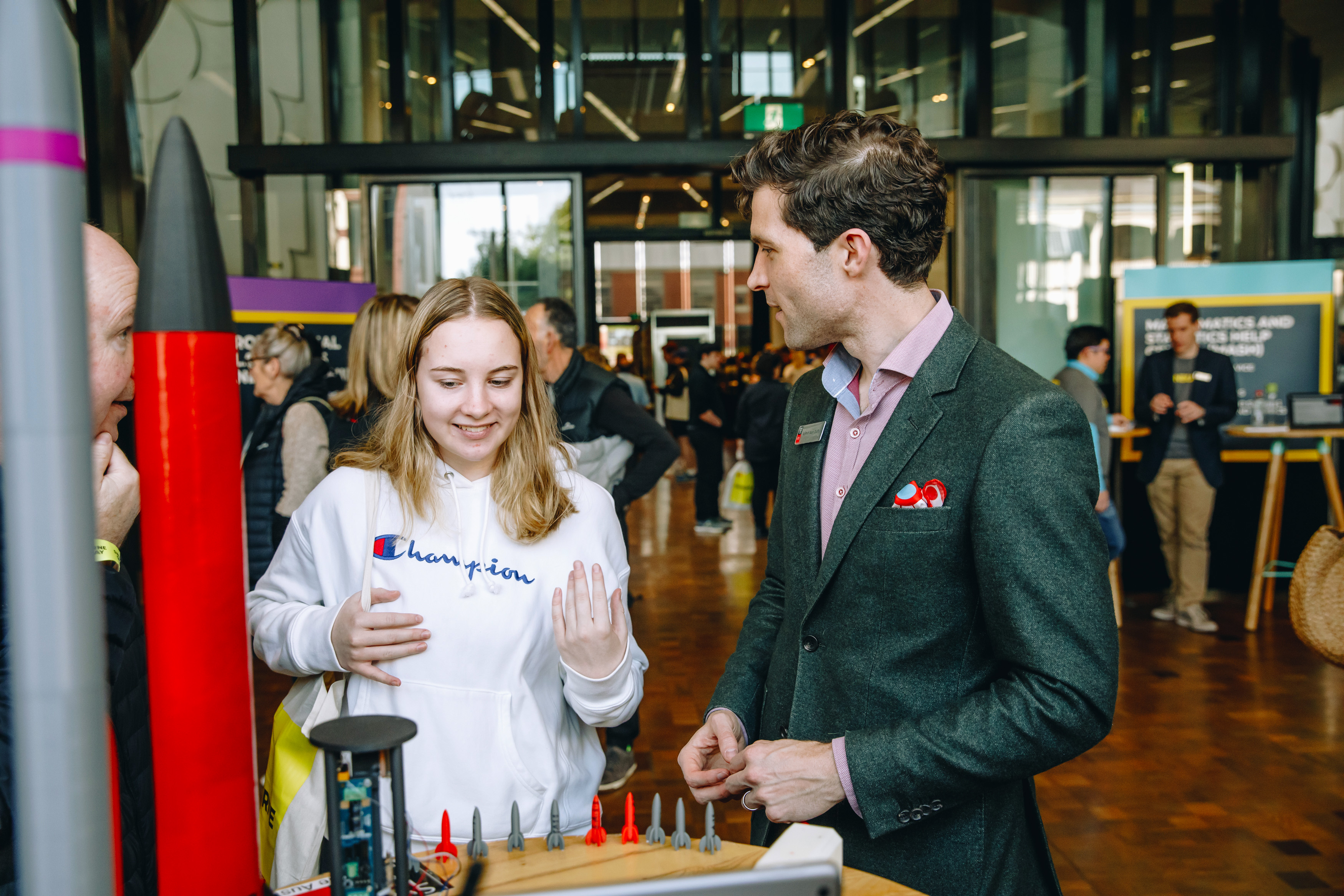One year since blast off for Space Institute

Director of the Space Technology and Industry Institute Alan Duffy speaks with a student.
In summary
- Swinburne’s Space Technology and Industry Institute is celebrating its first year of operations, after launching on 31 January 2021.
- From vocational training to PhDs, research and industry partnerships, the Institute is powering an industry estimated to be worth $1 trillion by 2040.
- The Institute’s achievements range from our students exploring the possibilities of creating yoghurt in space, to a multimillion-dollar partnership creating lighter, stronger and greener parts for spaceships.
In just 12 months, the team at the Space Technology and Industry Institute at Swinburne University of Technology have fought the spiralling threat of space junk, won precious time on the remarkable James Webb Space Telescope, and helped our students send microbes into space to explore making yoghurt in microgravity.
Led by Professor Alan Duffy, the Institute is fostering education at every level, from vocational training to PhD, and serving as the engine room for innovation and economic growth in a sector projected to be worth $1 trillion globally by 2040.
Explore some of the Institute’s amazing achievements since launch in early 2021.
Space tech making a difference on Earth
- Swinburne scientists have a front-row seat to one of the most important scientific projects of the century, the James Webb Space Telescope. Distinguished Professor Karl Glazebrook and Associate Professor Ivo Labbe from the Centre for Astrophysics and Supercomputing are leading projects awarded precious time in the first observation cycle of the telescope, which ‘will revolutionise the study of space’.

- Swinburne and our partners are helping fight the snowballing threat of space junk, through a project called Responsible AI in Space. Read Professor Alan Duffy in The Age on how we’re helping maximise the benefits of AI and avoid potentially catastrophic results.
- Alongside NASA, Microsoft and Geoscience Australia, we supported the EY Data Science Challenge which saw over 10,000 entries worldwide creating AI to help spot bushfires from space for the Country Fire Authority.
- We also made countless discoveries about how our universe works, with the team at OzGrav observing a truly remarkable event of a neutron star collide with a black hole, as well as witnessing a cosmic romance unfold and confirming that newly-created stars create a kind of space pollution.

Artist's impression of neutron star-black hole merger. Image: Carl Knox - OzGrav, Swinburne
Connecting with industry
- mDetect, a spin-out company from Swinburne, is using particles from space known as muons, to help mining companies detect weaknesses in dams that secure highly toxic mining waste by-products and make them environmentally safer.
- Our multimillion-dollar partnership with additive manufacturing company Titomic is helping us create lighter, stronger and greener structures for space. One of only two systems in the world, the Titomic TKF1000 system will give students, researchers and partners the ability to create rocket nozzles, satellite components and high-performance coatings for radiation shielding and hypersonic protection.
Propelling our students to the stars
- School students in our Swinburne Space Youth Innovation Challenge and SHINE program have sent bacteria to space to boldly grow where no students have grown before and test the possibilities of creating yoghurt in microgravity.

Students pose with their microgravity experiments on the way to the International Space Station.
- It’s ‘Lunacy’! Swinburne PhD candidate Matthew Shaw was the Asia-Pacific Winner of the Three Minute Thesis competition for his presentation on how to make metal on the Moon.
- Our student team won Deloitte’s Australia-UK GRAVITY Challenge by using data from space to improve irrigation management, developing a sophisticated user interface to optimise water use for SA Water.
Celebrating our space superstars
- Dr Rebecca Allen was recognised for excellence in scientific research and communications with a prestigious Young Tall Poppy Science award. She was also nominated at the Australian Space Awards, as was Swinburne graduate Mikaela Verhoosel and space lawyer Kim Ellis.
- We celebrated Space Week with some (inter)stellar space songs, iconic space movies and TV shows, and a showcase of some of our amazing women astronomers. You can also check out this great colouring-in book on Women in Physics from PhD candidate Debatri Chattopadhyay.
- We helped answer some of the big questions in space for The Conversation, like do aliens exist? Is space infinite? How can I explore the universe from home?
-
Media Enquiries
Related articles
-

- Astronomy
- Technology
- Health
- Science
- University
- Sustainability
- Engineering
Swinburne highly cited researchers reach the top in 12 fields
Ten Swinburne academics have been named on the Highly Cited Researchers 2025 list, released by Clarivate
Tuesday 02 December 2025 -

- Astronomy
- Technology
- Science
- Engineering
Meet Swinburne’s Roo-ver Mission team
Roo-ver will be Australia's first lunar rover, and it’s being designed, built and tested in Australia. Swinburne is playing a key role in the design and construction of Roo-ver, through its involvement in the ELO2 Consortium.
Wednesday 26 November 2025 -

- Astronomy
- Technology
- Science
- Aviation
- Engineering
Shaping space innovation at the International Astronautical Congress
The 76th International Astronautical Congress (IAC) united over 7,000 delegates from more than 90 countries to explore the future of space. Swinburne staff and students delivered 20 talks, panels and presentations, showcasing Australia’s growing leadership in research and education.
Friday 10 October 2025 -

- Astronomy
Indigenous students explore the cosmos through Swinburne’s astrophysics program
Indigenous students explored astrophysics at Swinburne, connecting science and culture while building pathways to future careers in STEM.
Friday 19 September 2025 -

- Science
How to make metals from Martian dirt
Swinburne and CSIRO researchers have successfully made iron under Mars-like conditions. This is how they did it.
Tuesday 26 August 2025

